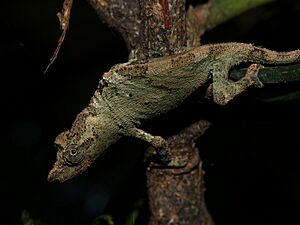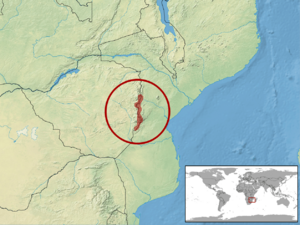Marshall's pygmy chameleon facts for kids
Quick facts for kids Marshall's pygmy chameleon |
|
|---|---|
 |
|
| Conservation status | |
| Scientific classification | |
| Genus: |
Rhampholeon
|
| Species: |
marshalli
|
 |
|
The Marshall's pygmy chameleon (Rhampholeon marshalli) is a tiny lizard. It is also known as Marshall's leaf chameleon or Marshall's dwarf chameleon. You can find this chameleon in the forests of Zimbabwe and Mozambique in Africa. It grows to be about 3.5 to 7.5 cm (1.4 to 3.0 in) long. This little chameleon eats insects. When it stays still, it looks just like a leaf on a branch!
Contents
What's in a Name?
The scientific name, marshalli, honors a British scientist named Guy Anstruther Knox Marshall. He was an entomologist, which means he studied insects. Mr. Marshall was the one who first collected this chameleon for scientists to study.
How to Spot a Marshall's Pygmy Chameleon
This tiny chameleon is easy to recognize because it is so small. It is the only chameleon of its size in the areas where it lives. These chameleons are usually between 3.2 and 7.5 cm (1.3 to 3.0 in) long. Female chameleons are often a little bigger than males.
Some groups of these chameleons are different sizes. For example, those found north of Mutare in Zimbabwe seem larger than those found south of it. This chameleon has a flat head and body. You can even see its ribs and veins, which makes it look even more like a leaf. Its color can change from dark brown to yellowish-green. This helps it blend in with its surroundings. Males usually have brighter colors.
How to Tell Males and Females Apart
It is fairly easy to tell male and female Marshall's pygmy chameleons apart. Males are a bit smaller. They have a small bump at the base of their tail. Males also have a greener throat with a line of white or yellow spots.
Chameleon Neighbors
The Marshall's pygmy chameleon lives in the same areas as another chameleon, the flap-necked chameleon (Chamaeleo dilepis). However, they do not often live in the exact same spots. The flap-necked chameleon prefers sunnier grasslands and forest edges.
Family Members
Other chameleons are related to the Marshall's pygmy chameleon:
- Rhampholeon gorongosae was once thought to be a type of Marshall's pygmy chameleon. Now, scientists say it is its own species. It lives in similar forests on Mount Gorongosa in Mozambique.
- Rhampholeon platyceps lives in similar forests on Mount Mulanje in Malawi.
Where They Live
You can find the Marshall's pygmy chameleon mostly in the Eastern Highlands of Zimbabwe. They also live in the nearby upland forests of Mozambique.
Their Home in the Forest
These chameleons live in small patches of old mountain forests. These forests are found in places like the Nyanga, Bvumba, Himalaya, and Chimanimani Mountains. They like the cool, wet parts inside the forest. They often live in the lower parts of the trees or at the edges of the forest.
These forest patches are often far apart. They are surrounded by large areas of grassland. However, forests along mountain streams can sometimes connect these small homes. Scientists have watched these chameleons and found that they do not travel far. They usually move less than 15 meters (about 50 feet).
Their Daily Life
Marshall's pygmy chameleons live in the lower parts of cloud forests. They also spend time in the leaves on the ground. The main trees in these forests include Syzygium and Ficus. These forests are full of ferns and climbing plants called lianas. The edges of the forest have thorny plants like Ilex and Rubus.
It is not known how high up in the trees these chameleons go. But they are usually found in the leaf litter or on low bushes. The winters in these forests are cold. It is likely that these tiny lizards have a period of rest, called brumation, during the cold months. They eat insects.
Reproduction
During the rainy season, from November to March, the female Marshall's pygmy chameleon lays a small group of eggs. These eggs hatch quickly. One time, a scientist saw a female digging a hole in the forest soil to lay her eggs. One egg was dug up and had a fully formed baby chameleon inside! After about 35 days, the eggs hatched. The tiny baby chameleons then spread out. Young chameleons are quite big when they hatch, about 22 to 25 mm (0.87 to 0.98 in) long.
Protecting Them
Like other small mountain chameleons, the number of Marshall's pygmy chameleons can go up and down. Their homes do not seem to be in danger right now. Much of their habitat in Zimbabwe is safe in places like Nyanga National Park. In this park, harmful trees are being removed so the natural forest can grow back. They also live in Stapleford Forest Reserve, Bunga National Park and Botanical Garden, Chimanimani National Park, and the Chirinda Forest Reserve.
However, these small cloud forest patches are always at risk. People sometimes collect too much firewood or clear land for coffee, tea, and protea farms. Also, the natural paths that once connected different groups of chameleons have become smaller. This makes it harder for them to move between safe areas.


